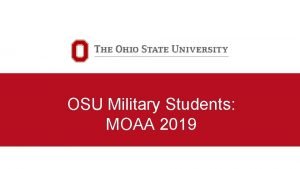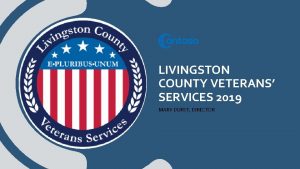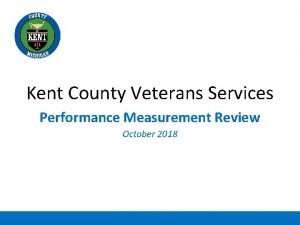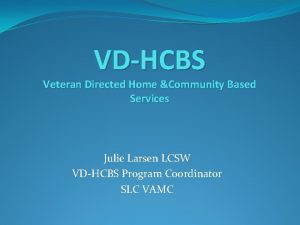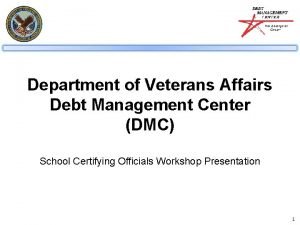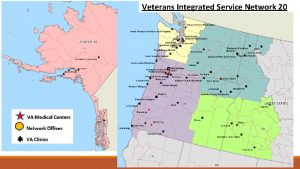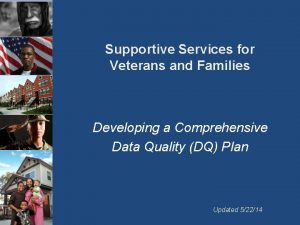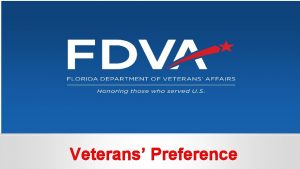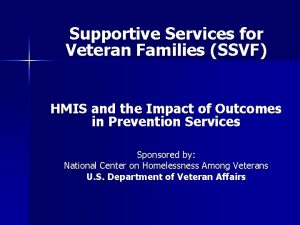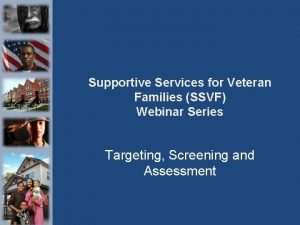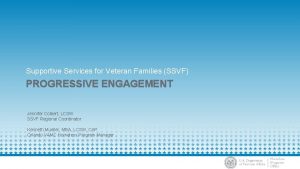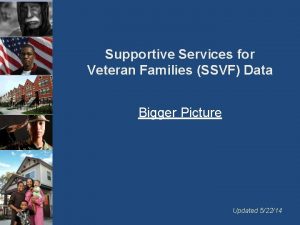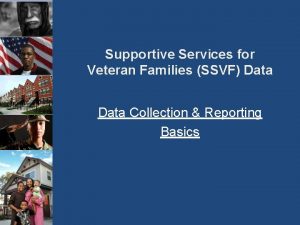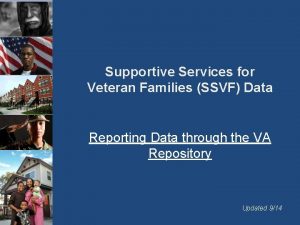Supportive Services for Veterans and Families Developing an





























- Slides: 29

Supportive Services for Veterans and Families Developing an Excellent Data Quality (DQ) Plan

What do we mean by Data Quality? Does your data reflect reality? Ø How accurately are you communicating the picture of homelessness in your community to others? Ø How accurately are you able to measure your progress towards achieving your goal of ending veteran homelessness? 2

Elements of a Data Quality Plan 1) Timeliness 2) Completenessa) All Clients Served b) Data Quality Benchmarks 3) 4) 5) 6) Accuracy Consistency Monitoring Incentives & Enforcement 3

Importance of Data Quality • Identifies the risk factors for Veteran homelessness • Identifies the needs of homeless Veterans • Identifies what works in ending homelessness and promoting housing stability • Know if you’re reaching target population • Inform your outreach approach • Know where changes are needed • Measure your progress against goals and benchmarks set 4

Data Quality & SSVF program – SSVF Legislation requires use of HMIS for client-level data collection – HMIS reports provide outcome data to VA – Paints the picture of veteran homelessness, informs national resource allocation. 5

SSVF Data Requirements • You must ask for every required data element for every client • Household members are clients • You must enter the data into HMIS accurately and completely • You must make every effort to enter and update client records in HMIS within 24 hours of data collection • You must make sure that your data is exported from HMIS and uploaded to the VA’s Repository every month Reference: Data Quality Policy & Thresholds Document 6

Data Quality (DQ) Standards Timeliness Completeness: All Clients Served Incentives & Enforcement Data Quality Completeness: DQ Benchmarks Monitoring Accuracy Consistency 7

1) Timeliness Is the client information, including intake data, program entry dates, services provided, and program exit dates entered into the HMIS within a reasonable period of time? 8

Timeliness Example • Standard: Client information is entered within 24 hours of intake. • Monitoring plan: Hard copy intake forms are date stamped when the client information is first collected. The dates on the forms are then compared to actual HMIS data entry dates by a program manager to determine if the time between initial collection and entry into HMIS is 24 hours or less. 9

2 a) Completeness: All Clients Served Are all of the clients receiving services being entered into the HMIS? Are all of the appropriate data elements being collected and entered into the HMIS? 10

Completeness Example • Standard- Maine: – The program shall enter data on 100% of the clients they serve in accordance with the data set outlined in the program type’s definition of record. No anonymous client records are allowed. – All clients must be exited from system within 24 hours of exit from program. – Don’t Know, Unknown, or Refused cannot be recorded in the HMIS because the question was not asked, the intake worker did not record the answer on the intake/assessment sheets, or the data entry worker does not have access to the information. – Policies on obtaining SSN, estimating DOB, Children & Veteran Status 11

Completeness- Sample Monitoring Plan • Monitoring Plan: – All programs must review, as part of their monthly data quality process, the list of current clients to ensure that client exits are recorded properly in the HMIS. – Run DQ Report weekly or bi-weekly to identify missing/refused/don’t know responses in advance of the upload. Find missing data or re-train case managers where needed. – Compare SSVF Dashboard Report #’s to HMIS #’s 12

2 b) Completeness: Establishing Data Quality Benchmarks/Thresholds • To ensure completeness of the data in these data element sets, all programs are required to meet the Data Quality Benchmark Rates as outlined by SSVF. Unlike other HMIS applications, SSVF sets data quality thresholds for you. • Standard: Data Quality Policy & Thresholds document • Monitoring Plan: Monthly uploads – Repository automatically classifies errors - Notify or Reject. 13

DQ Threshold: NOTIFY • At the Notify level, users are alerted to potential data quality issues, but the Repository will accept the upload. • For example, if any client record is missing a last name, the user will be notified. • Grantees are strongly encouraged to correct issues at the Notify level since missing data at these levels is a problem. 14

DQ Threshold: REJECT • In order for the Repository to process the data set, the export must be compliant with HUD’s XML or CSV standards • If not compliant (too many client records are missing essential data elements), the data set will be rejected by the Repository. You’ll receive a message either from us (if XML upload) or automatically generated from the Repository (if CSV upload) • If a data set is rejected because of missing data, SSVF program staff will have to update client records in HMIS and then upload corrected data into Repository again 15

3) Accuracy Does the HMIS data accurately and consistently match information recorded on paper intake forms and in client files? Determined by: 1. Truthfulness by the client 2. Accuracy of data collected by staff 3. Accuracy of data entered into the system by staff 16

Accuracy- Example • Standard: 100% of data entered into an HMIS must reflect what clients are reporting. • Monitoring Plan: SSVF program will, on a biweekly/monthly basis, run DQ report from HMIS to identify any required data elements with missing or unknown/refused responses. Data for active clients should be reviewed monthly. 17

4) Consistency To ensure a common interpretation of questions, answers, and process for data entry, including which HMIS fields require completion. 18

Consistency- Example Standard- Vermont: 1. Forms and Documentation: Universal Data Elements (UDE’s) are collected on initial intake. Use Co. C’s uniform intake, assessment and service documentation templates. Establish definitions of data points, interpretation of questions, answers and required fields. 2. Staff Training: a. New intake staff must complete training on both data collection and HMIS software prior to conducting assessments and using HMIS. Follow-up training in 3 months after gaining access to system. b. Regular training of data entry staff- must attend annual HMIS training, test and document proficiency on data elements and collection. 3. Program Flow: Standardized data entry screens and processes. Where appropriate, use software validations to force data entry and/or provide prompts to assist in data entry of valid data. Data flow will be reviewed at least annually. 4. Feedback loop: Regularly check paper to computer data. Run DQ report to identify bed utilization, missing/null data, percentage of unknown/don’t know/refused data. Compare paper records to identify issues. 19

5) Monitoring • To ensure that the standards on the extent and quality of data entered are met • To identify DQ issues that affect timeliness, completeness and accuracy of the data. Resolve expediently. • Specify frequency of monitoring activities. 20

Monitoring Plan- Example: Maine 1. 2. Establish internal data quality assurance procedure. Designate HMIS DQ Lead. This person should contact case managers whose data elements do not meet the benchmarks and assist in identifying solutions for correcting the data. Assistance provided by the HMIS Lead include: • Assist in generating data quality reports showing instances of client level null/missing and/or unknown/don’t know/refused; • Assist in identifying potential changes to workflow to better accommodate data collection and data entry for the program; • In depth analysis of technical issues that may be causing reporting errors on data quality; • Providing training on data entry; • Providing training on data element definition and meaning; • Clarification on exceptions to data quality standards. • HMIS DQ Lead should not correct data, rather will help identify problems and teach case managers how to correct. • HMIS DQ Lead should document individual staff DQ issues on monthly basis. • Program Manager should be final reviewer for data submitted for reports. 21

Finding & Correcting HMIS Errors • Most HMIS applications have data quality reports that can help identify records with missing data. • Exported CSV files open in Excel and every record has a Personal Identification Number that uniquely identifies a client. • If your HMIS exports XML, you may be able to use the XML->CSV Parsing Tool. • Resolving issues may take some time – upload to the Repository as early as possible each month to allow extra time to make corrections and resubmit data. Ask for help if you need it! Reference: SSVF Data Quality Policy & Thresholds 22

Common Errors • Name First and Last name not same; Suffix properly formatted; No numerals in name fields; Suffixes not in last name field, First name is not “Husband, ” “Wife, ” “Man, ” “Woman, ” “Boy, ” “Girl, ” “Child”, “Baby, ” , etc. • Social Security Number SSN has all numbers and no dashes; 9 digits when quality code indicates complete; Less than 9 digits when code indicates partial; All digits not same (33333); all numbers not sequential (123456789) • Date of Birth Earlier than current date; Earlier than program entry date; Later than 90 years from present; Not minor in adult shelter • Ethnicity/Race Primary and secondary race not the same • Gender Men not pregnant; No Male referred from woman’s shelter/Woman referred from men’s shelter • Veteran Status Client under 18 not veteran; All veterans in veteran shelter; Those receiving veteran’s pension marked as veteran 23

Common Errors • Housing Status at Program Entry Response will determine whether client will be categorized as RRH or HP in the APR • Incomes should be reasonable, no extra digits, misplaced decimals • Disabling Condition Those receiving SSDI for themselves are marked as having a disability; Those indicating substance abuse, mental health, physical disability, developmental disability, HIV/AIDS marked as having disability • Residence prior to program entry Self-report not contradicted by other HMIS data • Zip Code of Last Permanent Address/Quality Code Zip code complete if quality code marked a complete; Zip code five or nine characters; Zip code valid (If list of zips available); Zip code has only numbers • Program Entry Date/ Program Exit Date All clients have a program entry date. ; Program Entry Date later than Birth Date; Program Entry Date prior to Exit Date; Length of program enrollment outliers are reasonable considering program type • Household ID Single person not in family shelter; Family not in individual shelter 24

Useful Data Quality Reports 1) Null/Missing and Unknown/Don’t Know/Refused Reports on Universal Data Elements 2) Universal Data Elements by Program Type – Benchmark for % Null/Missing and Unknown/Don’t Know/Refused 3) Program Data Elements by Program Type – Benchmark for % Null/Missing and Unknown/Don’t Know/Refused 4) Universal Data Elements by Client ID Report 5) Length of Stay Report by Client ID 6) Intake and Exit Data Entry Date Timeliness Report 7) Bed Utilization Tool 25

6) Incentives & Enforcement • Positively reinforce adherence to the data standards and achievement of excellent data quality • Set protocol and consequences for making corrections to data in a timely manner. 26

Incentives & Enforcement- Example Standards: • Annual recognition awards given to SSVF HMIS case managers who have substantially improved DQ and to those who consistently meet or exceed DQ standards. • Co. C publicly posts among its members the monthly DQ ranking for each program 27

Questions to Ask as You Develop Your DQ Plan • Does your Co. C have a set of HMIS data standards? If so, take a look at them… • If they don’t meet the standards stated above, you can raise the bar and set a higher standard! • Does your local HMIS have additional requirements not mentioned here? If so, do they conflict with SSVF requirements? Contact Regional Coordinator to request TA if needed. 28

Get Started Developing Your Excellent Plan: 1. Establish specific guidelines for all above standards. Put in writing. Borrow from other successful programs! 2. Train SSVF staff on each data collection and entry standards, roles and responsibilities. 3. Test data collection workflow and tools (before you begin to serve clients!) 4. Designate staff roles & responsibilities for creating, implementing and monitoring plan. 5. Meet weekly w/ SSVF staff to address questions, issues and to ensure consistency. 29
 Osu military
Osu military Big families vs small families
Big families vs small families Veterans administration daytona beach
Veterans administration daytona beach Livingston county veterans services
Livingston county veterans services Riverside county vso
Riverside county vso Kent county veterans services
Kent county veterans services Developing and pricing goods and services
Developing and pricing goods and services Developing new products and services
Developing new products and services Veterans directed home and community based care
Veterans directed home and community based care Vd hcbs
Vd hcbs Uccs health circle
Uccs health circle Goldman sachs veterans integration program
Goldman sachs veterans integration program Va.gov/debtman
Va.gov/debtman Medical lake veterans cemetery
Medical lake veterans cemetery Maryland commitment to veterans
Maryland commitment to veterans Tvc hazlewood
Tvc hazlewood Visn 20
Visn 20 Parabat veterans organisation
Parabat veterans organisation Syracuse veterans transition program
Syracuse veterans transition program Vaforvets
Vaforvets Mechling shakley veterans center
Mechling shakley veterans center Veterans health administration organizational chart
Veterans health administration organizational chart Va form 10-250
Va form 10-250 Utsa military affairs
Utsa military affairs Veterans basic entitlement is $36 000
Veterans basic entitlement is $36 000 Veterans employment opportunity act
Veterans employment opportunity act Indiana disabled veteran plates
Indiana disabled veteran plates Georgia department of veterans service
Georgia department of veterans service Corrective discipline in the classroom
Corrective discipline in the classroom Directive behavior and supportive behavior
Directive behavior and supportive behavior
